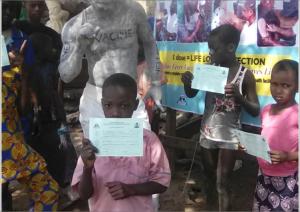Nigeria targets nearly 12 million in Yellow fever vaccination across two high risk States
Abuja, 28 February 2020 – Determined to protect the country against an outbreak of Yellow fever, the Government of Nigeria with support of the World Health Organization (WHO), and Gavi, the Vaccine Alliance, is launching a Yellow fever preventive mass vaccination campaign to commence in Rivers State on the 28 February 2020, aimed at reaching nearly 12 million persons in Rivers and Anambra States.
The campaign is part of a series of phased preventive campaigns to protect Nigeria from Yellow Fever. It is also part of the global strategy to Eliminate Yellow Fever Epidemics (EYE) by 2026. Nigeria is a priority country for the EYE Strategy and it is expected that more that almost 160 Million Nigerians will be protected against yellow fever by the end of 2026 through preventive mass vaccination campaigns alone.
Since 2017, 46 million people in Nigeria have been protected through preventive and reactive campaigns. The Yellow fever preventive mass campaign in Rivers state provides opportunity to protect more than 6.5 million persons aged 9 months to 44 years. The next scheduled campaign is planned for April 2020 in Anambra state, where yellow fever vaccination will be combined with meningococcal A conjugate (MenA) vaccine.
Following these campaigns planned in the two states, seven (7) other states are proposed for yellow fever vaccination campaigns later in the year as part of Nigeria’s accelerated EYE plan. This will create an opportunity to vaccinate another 32 million persons before the end of the year.
With the support from WHO, UNICEF, Gavi, and other partners, Nigeria has developed a 10-year strategic elimination plan to improve yellow fever diagnosis capacity, childhood immunization and overall population immunity in all states. Towards this aim, the country plans to bring together states and engage with partners to increase the momentum and development of the state-specific EYE implementation plans. The global EYE risk analysis working group will support this effort through an evidence-based risk analysis informed by local expert assessment, to inform equitable allocation of vaccine to protect the population.
“Protection against Yellow fever for life is the ultimate goal. All eligible in Rivers State should make use of the opportunity to be protected against the disease,” Stated Dr Joseph Oteri, Director of Disease Control and Immunization, NPHCDA.
“We encourage all eligible persons in the state to come forward and get vaccinated. Yellow fever outbreaks have re-emerged as a serious public health concern since September 2017. In 2019 alone over 4213 suspected cases of Yellow fever cases were reported in Nigeria across all 36 states and the FCT. Of these, 183 cases were confirmed in 21 states and the FCT.” He added.
“The Yellow fever vaccine confers lifelong protection and is the most effective tool to prevent outbreaks of this potentially deadly disease,” said Thabani Maphosa, Managing Director for Country Programmes at Gavi. “Gavi is committed to supporting the government of Nigeria and partners in their efforts to fast track implementation of the Yellow Fever elimination strategy and protect the millions of Nigerians, including children, who are at risk.”
Gavi is supporting the Government of Nigeria by funding preventive and reactive campaigns, including operational costs. This support is critical given Nigeria’s status as a high priority country for the EYE Strategy, and the prevalence of yellow fever outbreaks in the country.
In 2003, the Alliance helped create the international stockpile that countries eligible for Gavi support can call on for use during emergency outbreaks. Since then, more than 62 million doses of yellow fever vaccine have been distributed for outbreak response and 133 million people have been protected through 14 preventive campaigns with Gavi support.
Dr Fiona Braka, the WHO Team Lead of the Expanded Programme on Immunization (EPI) stated that, “WHO is providing technical support at National and State level to insure high quality campaign including planning, trainings of health care workers, supervision of the campaign and vaccination coverage. WHO and partners are committed to ensuring that every person at-risk of yellow fever is protected,”
Note to Editors
Yellow Fever is a viral infection transmitted by infected mosquitos. The infection can cause serious disease, including fever and jaundice (yellowing of the eyes) and can even lead to death. The disease has re-emerged as a public health threat in recent decades, triggered by different factors such as climate change, increasing population movement and distribution of mosquito vectors.
Technical Contact:
Dr Anne Eudes Jean Baptiste; Email: jeana [at] who.int (jeana[at]who[dot]int); Tel: +234 813 173 6281



